Texas is home to an impressive variety of oak trees, each uniquely adapted to the state’s diverse climates and landscapes. From the towering Live Oak in the Hill Country to the drought-tolerant Sandpaper Oak of West Texas, these trees play a vital role in the local ecosystem and add beauty to both wild and urban settings. Understanding the different types of oak trees in Texas can help landowners, gardeners, and nature enthusiasts identify native species and make informed choices for landscaping or conservation.
With over 20 native species found across the state, the types of oak trees in Texas vary widely in size, leaf shape, bark texture, and growing preferences. Some thrive in wet bottomlands, while others are best suited for dry limestone hills or sandy prairies. This diversity allows oaks to be used in nearly any Texas environment, whether you’re planning a natural wildlife habitat, planting a shade tree, or identifying species on a hike.
This guide showcases 21 well-known types of oak trees in Texas, complete with photographs and identification tips. It serves as a useful reference for anyone interested in recognizing native oaks, enhancing local landscapes, or simply appreciating the natural beauty these trees provide throughout the Lone Star State.
Different Types of Oak Trees in Texas
Live Oak (Quercus virginiana)

The Live Oak is one of the most iconic and widespread oak trees in the southern United States, especially throughout Texas. This evergreen oak is known for its broad, spreading canopy, with limbs that often grow horizontally and dip close to the ground. It typically reaches a mature height of 40 to 80 feet, but its impressive horizontal spread can exceed 100 feet, making it a stunning shade tree in both urban and rural landscapes.
Its leaves are leathery, dark green, and oblong, typically 2 to 4 inches long with a smooth or slightly wavy margin. Unlike deciduous oaks, the Live Oak retains its leaves throughout most of the year, only briefly shedding old ones in spring as new foliage emerges. The bark is dark gray and furrowed, providing a striking contrast against its vibrant canopy. The tree grows moderately fast in early years and thrives in USDA zones 7 to 10.
Live Oaks prefer well-drained soils but are highly adaptable to sandy, loamy, or clay-based soils. Their tolerance to drought, wind, and occasional flooding makes them a favored choice for large landscapes, city parks, ranch properties, and historic sites. This species is also valued for its wildlife support, offering shelter and acorns to many birds and mammals.
Shumard Oak (Quercus shumardii)
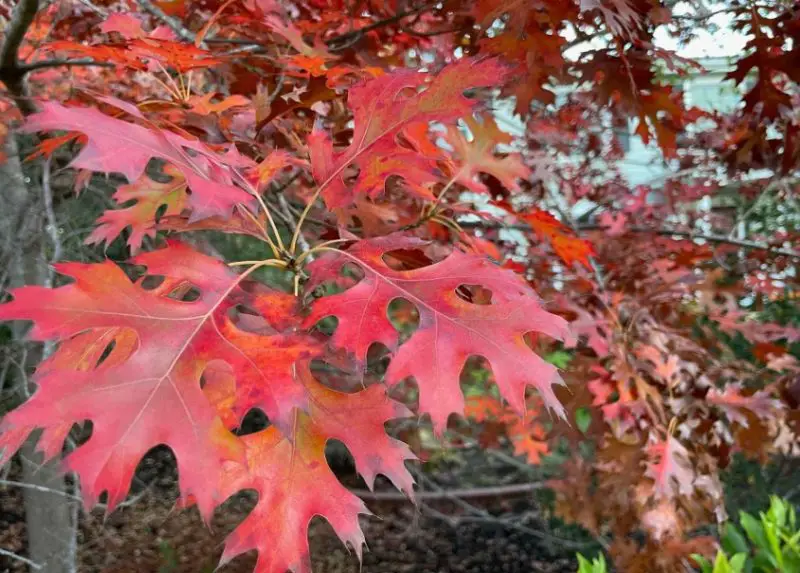
Shumard Oak is a large, deciduous oak known for its stately form and brilliant red fall foliage. It typically grows 50 to 90 feet tall with a straight trunk and an upright, rounded crown. This species is commonly found in both wild forests and urban environments across much of Texas due to its striking seasonal color and adaptability.
The leaves are deeply lobed with pointed tips, resembling those of red oaks. They usually range from 4 to 8 inches long and turn a vivid red to reddish-orange in autumn. The bark is gray and smooth in young trees, becoming darker and ridged with age. Shumard Oaks grow at a medium to fast rate and prefer full sun. They are best suited to USDA hardiness zones 5 to 9.
This oak thrives in deep, well-drained soils, particularly in areas near rivers or in bottomlands, but it can tolerate alkaline and clay-rich soils. Its symmetrical growth and tolerance of urban conditions make it ideal for street plantings, shade trees in parks, and large residential yards. It also provides a reliable source of acorns for wildlife.
Post Oak (Quercus stellata)
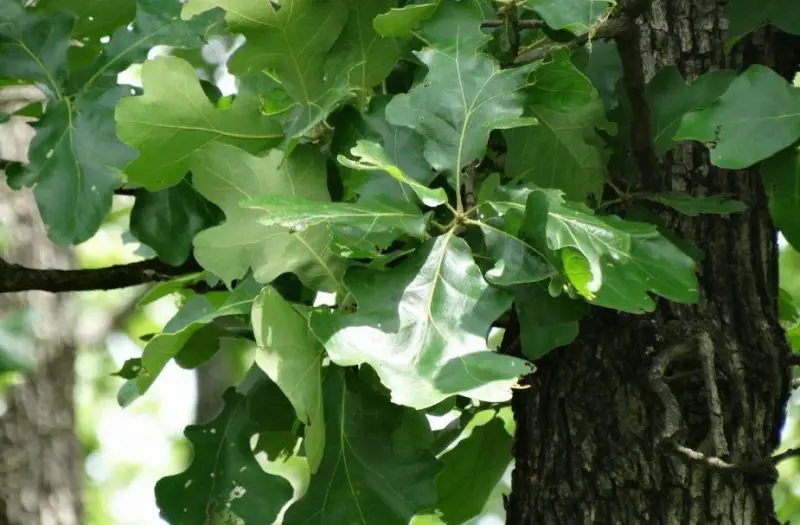
Post Oak is a tough, slow-growing deciduous tree native to Texas woodlands, known for its resilience in dry, rocky, and poor soils. It generally reaches heights between 35 and 50 feet and has a broad, rounded crown. It often grows in open areas or as part of mixed hardwood forests across central and eastern Texas.
The leaves are distinctive, with five lobes that form a shape similar to a Maltese cross, usually 4 to 6 inches long. The foliage is thick and leathery, turning yellow-brown in autumn. Its bark is light gray and rough, often ridged with scaly plates. Post Oak has a slow growth rate, but its longevity and ruggedness make it a reliable part of the Texas landscape. It is hardy in USDA zones 6 to 9.
Post Oak prefers dry, sandy, or gravelly soils and is extremely drought-tolerant once established. While it is not often used in formal landscapes due to its slow growth and somewhat rugged form, it is important in native and xeriscape plantings, especially in regions where water conservation is critical. It also serves as a habitat and food source for many native animals.
Chinkapin Oak (Quercus muehlenbergii)
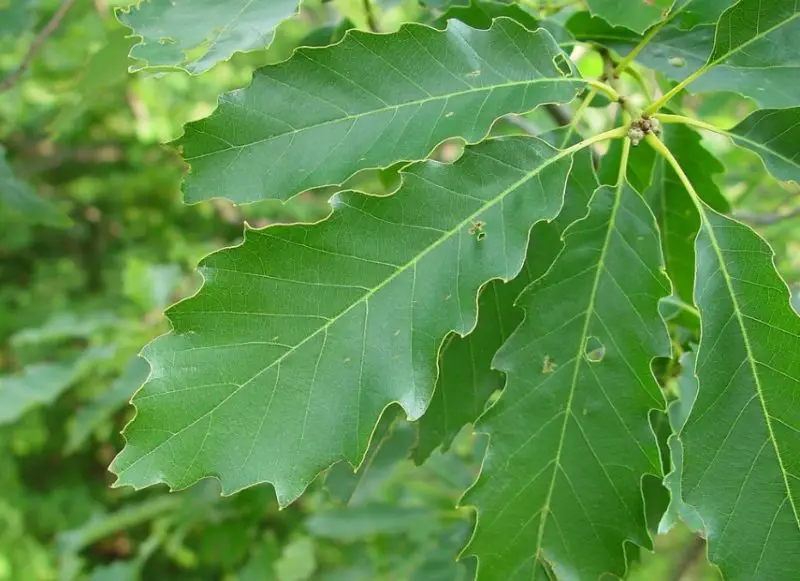
Chinkapin Oak is a medium to large deciduous tree native to limestone regions of Texas. It typically reaches a height of 40 to 70 feet and features a rounded crown. This species is known for its light-colored bark and leaves that resemble those of the chestnut, giving it its common name.
The leaves are narrow, oblong, and coarsely toothed, resembling a saw blade. They are bright green on top and pale underneath, turning yellow to bronze in fall. The bark is a distinguishing feature—light gray and flaky, often mistaken for that of the white oak. Chinkapin Oak grows at a moderate rate and performs best in full sun, thriving in USDA zones 5 to 9.
It prefers well-drained, alkaline soils, especially in rocky or limestone-rich environments. Because of its tolerance to drought and poor soils, Chinkapin Oak is well-suited for naturalized landscapes, large yards, and public spaces. Its sweet acorns are a favorite among wildlife, especially deer and turkeys, making it ecologically valuable as well.
Bur Oak (Quercus macrocarpa)
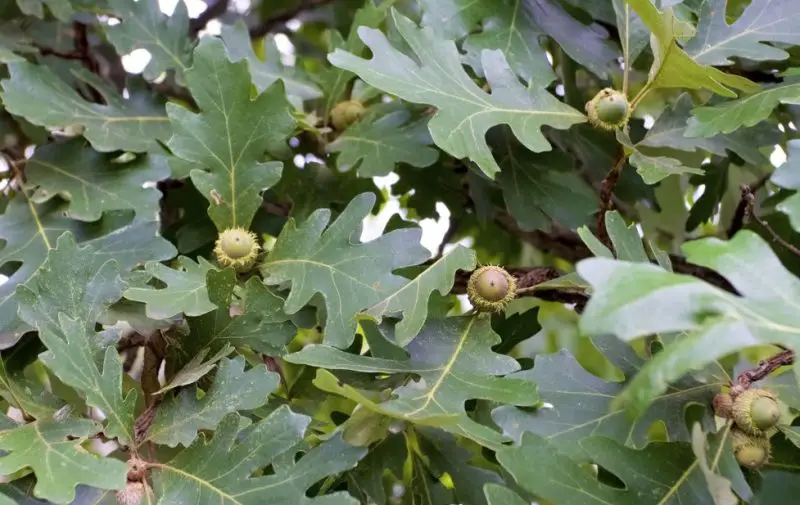
Bur Oak is a stately and long-lived oak known for its massive trunk, large leaves, and oversized acorns. It is one of the most cold-hardy oaks and is found across a broad range of Texas habitats, particularly in the central and northern parts of the state. It can reach towering heights of 70 to 100 feet, with a broad and irregular crown.
The leaves are large—up to 12 inches long—with deep lobes and a rounded shape. They turn yellow or brown in autumn. The acorns are among the largest of all oaks, often with a fringed cap that gives them a bur-like appearance. Its bark is thick, ridged, and deeply furrowed, providing excellent insulation against fire. Bur Oak grows slowly to moderately and thrives in USDA zones 3 to 8.
It prefers deep, rich soils but is highly adaptable to clay, limestone, and even compacted soils. Its tolerance to pollution and drought makes it a good choice for urban planting, large estates, and restoration projects. The tree is also valued for its impressive shade and wildlife benefits, attracting birds, squirrels, and other mammals.
Water Oak (Quercus nigra)
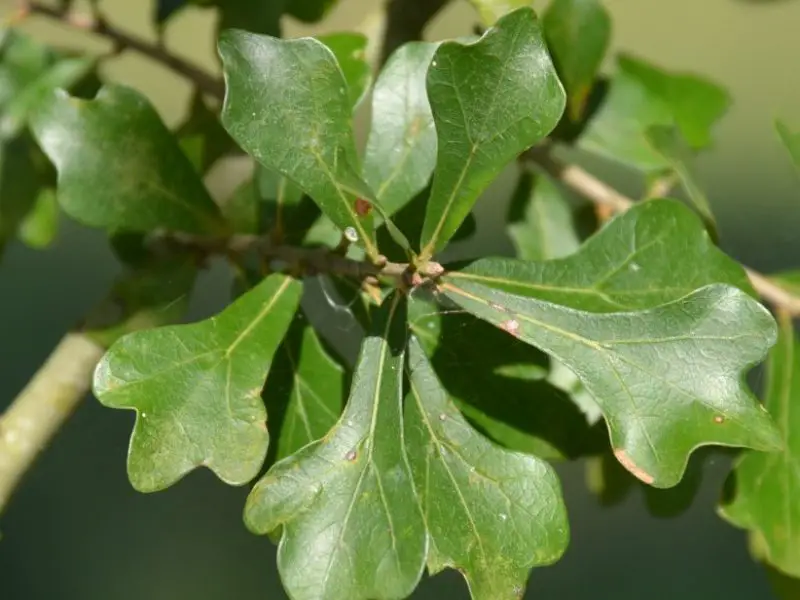
Water Oak is a fast-growing deciduous tree commonly found in the southeastern United States, including the eastern parts of Texas. It typically grows between 50 to 80 feet tall with a broad, rounded crown and is often used as a shade tree in moist, low-lying areas. Its rapid growth and ability to adapt to wet soils make it a popular choice for landscape and reforestation projects.
The leaves of Water Oak are variable but usually spoon-shaped or oblong, around 2 to 4 inches long with a smooth edge or shallow lobes. They are bluish-green on top and pale underneath, turning dull yellow or brown in fall before dropping. The bark is grayish-brown and becomes scaly as the tree matures. This oak thrives in USDA zones 6 to 9 and prefers full sun to partial shade.
Water Oak grows well in moist, acidic soils but can also tolerate poorly drained clay or sandy conditions. Although its lifespan is relatively short for an oak (usually around 60 to 80 years), it provides quick canopy cover and is often planted in large yards and naturalized areas. The tree also supports various wildlife, offering acorns for deer, squirrels, and waterfowl.
Southern Red Oak (Quercus falcata)

Southern Red Oak is a large, durable deciduous tree commonly seen across eastern and central Texas. It typically grows 60 to 90 feet tall with a broad, rounded crown and is admired for its rugged strength and vibrant fall color. It thrives in dry, upland areas and is often part of hardwood forests or used in open landscapes.
Its leaves are 5 to 9 inches long with deeply cut lobes, often with a distinctive bell-shaped base and bristle-tipped points. The upper surface is dark green, while the underside is paler and covered with fine hairs. In autumn, the foliage turns red, orange, or russet. The bark is dark gray to black and becomes deeply furrowed with age. Southern Red Oak is suited to USDA zones 6 to 9 and prefers full sun.
This oak grows best in sandy or loamy soils with good drainage and is highly tolerant of drought and heat once established. Its large size and dramatic foliage make it a striking choice for parks, large yards, or wildlife-friendly landscapes. The acorns provide an important food source for birds and mammals, making it both ecologically valuable and ornamental.
Willow Oak (Quercus phellos)
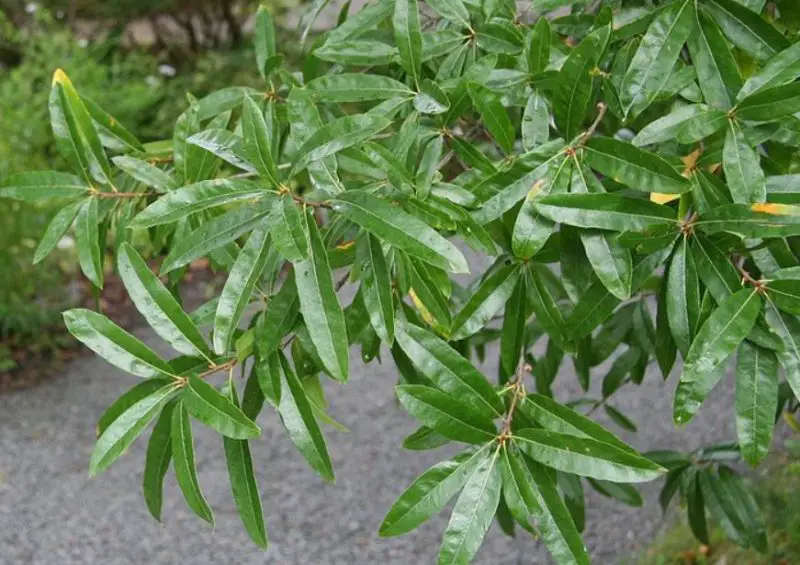
Willow Oak is a fast-growing, medium to large deciduous tree widely planted for its attractive shape and fine-textured foliage. It commonly grows 50 to 80 feet tall and features a straight trunk with a symmetrical, rounded canopy. Native to eastern Texas, it is often used in urban landscapes and along streets due to its neat appearance and adaptability.
Unlike most oaks, Willow Oak has narrow, lance-shaped leaves that resemble those of willow trees. They are smooth-edged, 2 to 5 inches long, and turn golden yellow or copper in the fall. The bark is light brown and becomes rough and ridged as the tree matures. Willow Oak is hardy in USDA zones 6 to 9 and does best in full sun.
It prefers moist, acidic soils but tolerates a range of conditions, including periodic flooding and urban pollution. Because of its upright form, moderate root spread, and manageable size, it is a favorite for residential streetscapes, commercial properties, and parks. Its acorns are small but plentiful, feeding various birds and small mammals.
Texas Oak (Quercus buckleyi)
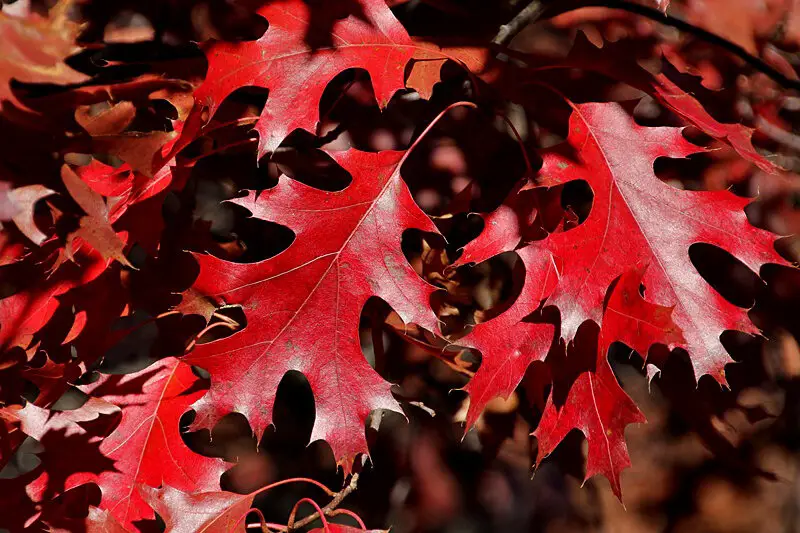
Texas Oak, also known as Buckley Oak or Spanish Oak, is a small to medium-sized deciduous oak native to the Texas Hill Country and parts of central Texas. It generally grows 30 to 50 feet tall with an open, rounded crown. Known for its stunning fall colors, it brings brilliant reds, oranges, and burgundies to the autumn landscape.
The leaves are deeply lobed with pointed bristle tips, often resembling those of Shumard Oak but smaller and more irregular in shape. They turn vivid red in the fall, adding ornamental value. The bark is dark gray with shallow furrows, and the acorns are small and rounded. This species grows best in USDA zones 7 to 9 and prefers full sun exposure.
Texas Oak thrives in thin, rocky limestone soils where many other trees would struggle. It is drought-tolerant, low-maintenance, and well-suited for native and xeric landscapes. Its compact size and vibrant seasonal color make it ideal for small yards, natural areas, and habitat restoration projects, especially where water conservation is a concern.
Lacey Oak (Quercus laceyi)

Lacey Oak is a small, deciduous oak tree native to the Edwards Plateau and southwestern Texas. It typically grows 25 to 40 feet tall with a rounded, compact crown, making it a favorite for urban gardens and smaller landscapes. It is known for its soft blue-green foliage and graceful form.
The leaves are 2 to 4 inches long, with rounded lobes and a pale silvery underside, often resembling those of white oak. In autumn, the leaves turn pinkish or golden-yellow before dropping. The bark is smooth and gray when young, becoming slightly fissured with age. Lacey Oak is well-suited for USDA zones 7 to 9 and thrives in full sun.
This oak prefers well-drained, alkaline soils, especially those rich in limestone. It is heat- and drought-tolerant once established and is low-maintenance in the landscape. Lacey Oak is ideal for residential gardens, streetscapes, and areas with limited space. Its compact size, attractive foliage, and wildlife value make it a standout native species in Texas landscaping.
Blackjack Oak (Quercus marilandica)

Blackjack Oak is a small to medium-sized deciduous tree known for its rugged appearance and ability to thrive in poor, sandy, or rocky soils. It typically grows 20 to 50 feet tall with a spreading, irregular crown and is often found in dry upland areas across eastern and central Texas. Though not typically used for timber, it plays a valuable role in wildlife habitats and native plantings.
The leaves are thick and leathery, usually 4 to 8 inches long, with three broad lobes that resemble a bell or club. They are dark green and glossy on top with a rusty-hairy underside. In fall, they turn shades of red and brown before dropping. The bark is dark and rough, with deeply furrowed ridges. Blackjack Oak grows best in USDA zones 6 to 9 and prefers full sun exposure.
This oak is highly tolerant of drought, nutrient-poor soils, and even fire, making it ideal for natural landscapes, restoration projects, and tough sites. Though its growth rate is slow and its form often twisted, it provides excellent cover and acorns for wildlife such as deer and turkeys. Its hardiness makes it a dependable choice for xeric or rustic garden settings.
Cherrybark Oak (Quercus pagoda)

Cherrybark Oak is a tall, fast-growing deciduous tree considered one of the best timber-producing oaks in the southern U.S., including eastern Texas. It typically reaches 80 to 120 feet in height with a straight trunk and a broad, symmetrical crown. It is closely related to Southern Red Oak but has superior form and wood quality.
The leaves are 5 to 9 inches long with 5 to 11 bristle-tipped lobes, arranged in a pagoda-like pattern, giving the species its name. The foliage is glossy green on top and paler underneath, turning red or orange in the fall. Its bark is smooth and reddish-gray when young, becoming scaly and dark like that of a cherry tree as it matures. Cherrybark Oak thrives in USDA zones 6 to 9 and prefers full sun.
It favors deep, well-drained loamy soils and is commonly found in bottomlands or on high ridges with good drainage. Due to its upright form, dense shade, and valuable lumber, it is often used in reforestation and large landscape plantings. Its acorns are a vital food source for many woodland animals, while its size makes it suitable for parks and rural properties.
Swamp Chestnut Oak (Quercus michauxii)
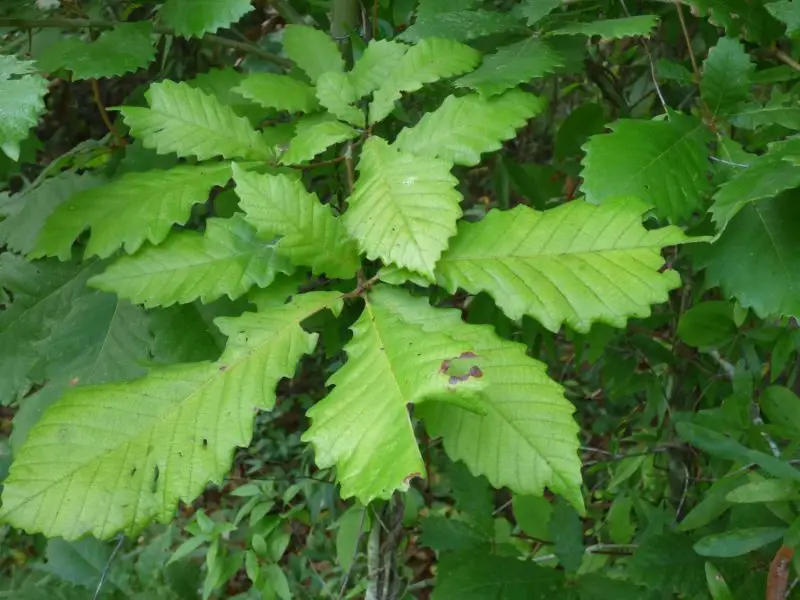
Swamp Chestnut Oak is a large deciduous tree native to wet bottomlands and floodplains across the southeastern U.S., including eastern Texas. It grows 60 to 100 feet tall with a wide, rounded canopy and is appreciated for its beautiful bark and impressive fall foliage. Its adaptability to moist soils makes it ideal for riparian planting.
The leaves are large and oblong, 4 to 8 inches long, with rounded, saw-toothed edges resembling those of chestnut trees. They are dark green above and lighter below, turning rich red or bronze in the fall. The bark is light gray and flaky, often peeling in long strips, which adds ornamental appeal. Swamp Chestnut Oak grows best in USDA zones 6 to 9 and prefers full sun to partial shade.
This oak thrives in moist, acidic soils but can tolerate brief flooding and periodic drought. It is often used in parks, floodplain restoration, and as a stately shade tree. Its large acorns are sweet and edible, highly favored by wildlife and sometimes even eaten by people. The wood is strong and valued for furniture and flooring.
Bluejack Oak (Quercus incana)
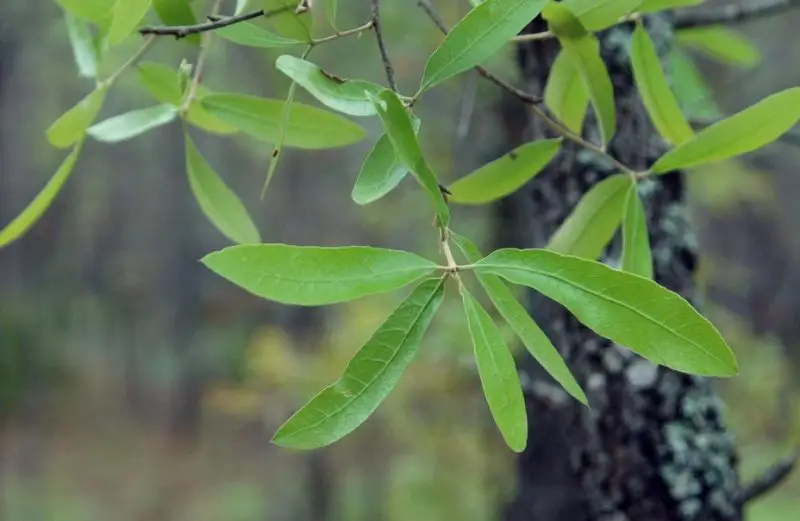
Bluejack Oak is a small, drought-tolerant deciduous tree or large shrub native to sandy soils in eastern Texas. It typically grows 15 to 40 feet tall with a narrow, open crown and a shrubby, irregular form. Its unique blue-green foliage and tolerance for infertile soils make it stand out in xeric landscapes and native plant restorations.
The leaves are narrow and elliptic, 2 to 5 inches long, with a bluish-green upper surface and a pale, fuzzy underside. They tend to remain on the tree late into fall, often turning dull yellow or reddish before dropping. The bark is dark and rough, forming scaly ridges with age. Bluejack Oak grows in USDA zones 7 to 9 and prefers full sun exposure.
This species is adapted to dry, sandy, and acidic soils where few other trees thrive. Though not commonly planted for landscaping due to its irregular shape, it is valuable in natural areas for erosion control and wildlife support. It produces small acorns that are eaten by birds and mammals and is fire-tolerant, making it suitable for pine-oak savannas and restoration projects.
Escarpment Live Oak (Quercus fusiformis)
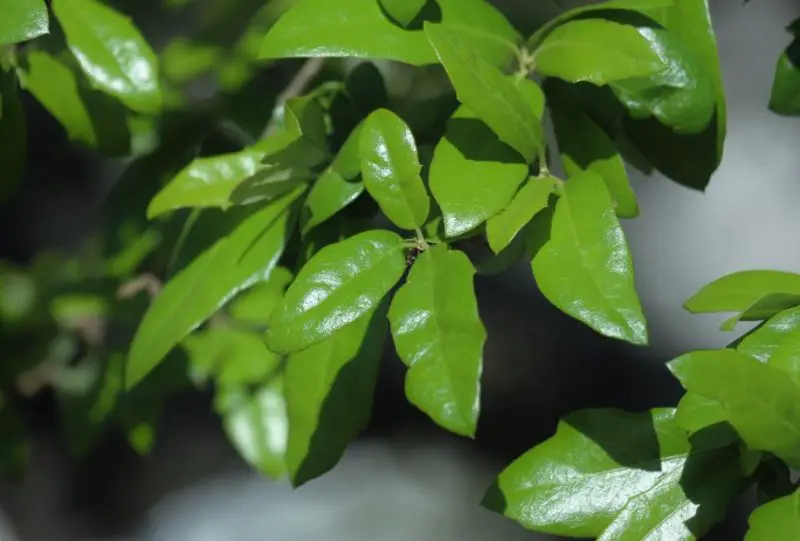
Escarpment Live Oak, also called Texas Live Oak, is a subspecies of the well-known Live Oak and is native to central and western Texas, particularly around the Edwards Plateau. It grows 30 to 50 feet tall, sometimes larger, with a broad, spreading crown and strong, gnarled branches. Its evergreen foliage and exceptional drought resistance make it a cornerstone of Texas landscaping.
The leaves are thick, leathery, and dark green, typically 1 to 3 inches long with smooth or slightly toothed margins. Unlike most oaks, this species retains its leaves year-round, contributing to year-long shade and beauty. The bark is gray to dark brown and becomes deeply ridged with age. Escarpment Live Oak thrives in USDA zones 7 to 10 and performs best in full sun.
It grows well in shallow, rocky limestone soils and is highly tolerant of drought, heat, and poor fertility. This oak is prized for its longevity, wind resistance, and aesthetic form, making it a common sight in Texas parks, ranches, and residential landscapes. Its acorns are important to wildlife, and its dense canopy offers excellent shade and habitat in dry environments.
Overcup Oak (Quercus lyrata)

Overcup Oak is a medium-sized deciduous tree well-suited to wet and poorly drained soils, often found in lowland areas, swamps, and floodplains across East Texas. It typically reaches 40 to 60 feet tall with a straight trunk and rounded crown, and it is highly tolerant of seasonal flooding. Its name comes from the way its acorn cap almost completely covers the nut.
The leaves are 4 to 8 inches long with deep, rounded lobes, resembling the shape of a lyre. They are dark green on top and pale, fuzzy beneath, turning yellow-brown in the fall. The bark is light gray and becomes scaly with age. This tree thrives in USDA zones 5 to 9 and grows best in full sun or partial shade.
Overcup Oak is valuable in wetland restoration and stormwater management projects because of its tolerance to saturated soils. Though its growth rate is moderate, its unique acorns and adaptability make it desirable for natural landscapes. Wildlife such as ducks and deer feed on its acorns, while its strong wood is occasionally used for construction and fuel.
Sandpaper Oak (Quercus pungens)

Sandpaper Oak is a small, shrubby evergreen oak found primarily in rocky, arid regions of western Texas and northern Mexico. It grows between 10 to 30 feet tall and is notable for its leathery, rough-textured leaves, which feel like sandpaper to the touch. This oak is highly drought-tolerant and thrives in limestone outcrops and canyon slopes.
The leaves are small, oval to elliptical, and coarsely toothed, measuring 1 to 2 inches long. They are dark green on top and pale and fuzzy beneath, retaining their foliage year-round. The bark is thin and light gray, becoming slightly furrowed over time. Sandpaper Oak grows best in USDA zones 7 to 9 and prefers full sun.
This oak is perfect for xeric landscaping, erosion control, and wildlife gardens. It supports various insects and birds, provides nesting cover, and its acorns serve as a food source for mammals. Its slow growth and rugged form make it a distinctive, low-maintenance choice for native and dryland gardens.
Bigelow Oak (Quercus sinuata)

Bigelow Oak, also known as Bastard White Oak or Durand Oak, is a medium-sized deciduous tree found in well-drained limestone soils across central and eastern Texas. It grows 40 to 70 feet tall with a wide-spreading canopy and is known for its adaptability and tolerance to alkaline conditions.
The leaves are variable in shape but generally have shallow, wavy lobes or sinuses, and are 4 to 6 inches long. They are green on top and lighter underneath, turning soft yellow or brown in fall. The bark is light gray, rough, and fissured. Bigelow Oak grows well in USDA zones 6 to 9 and prefers full sun.
Because of its ornamental foliage, drought resistance, and broad canopy, Bigelow Oak is increasingly used in urban and suburban landscapes. It thrives in rocky and calcareous soils where other species struggle. Its acorns are consumed by wildlife, and its moderate growth rate makes it manageable for yard and street plantings.
Mohr Oak (Quercus mohriana)
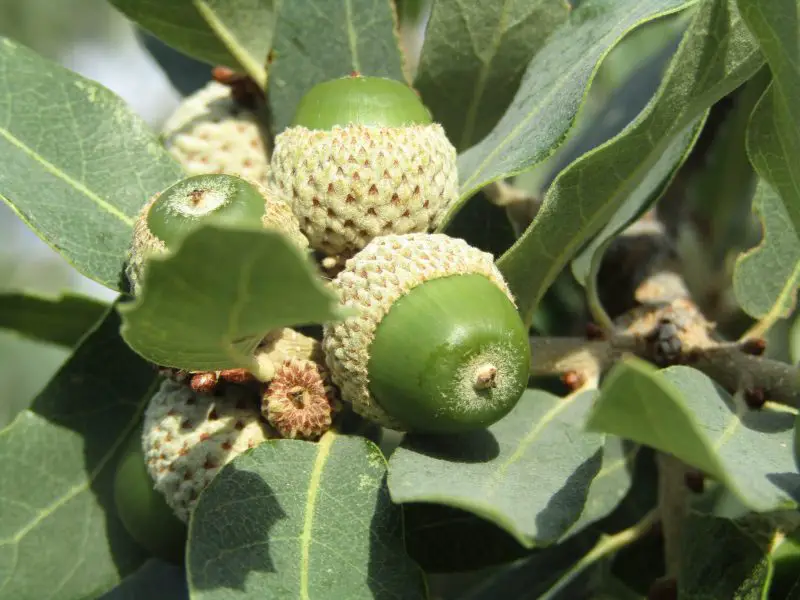
Mohr Oak is a small, deciduous to semi-evergreen tree or large shrub native to the limestone hills of central and western Texas. It typically grows 10 to 25 feet tall and is well-adapted to dry, rocky soils. This slow-growing oak is often multi-stemmed and displays a shrubby growth habit in harsh environments.
The leaves are small, leathery, and gray-green with shallow lobes or wavy edges. They are covered in soft hairs underneath, giving them a pale appearance. The bark is thin and light gray, becoming rough and scaly with age. Mohr Oak grows best in USDA zones 7 to 9 and requires full sun and excellent drainage.
It is ideal for native and wildlife-friendly landscapes due to its resilience in hot, dry climates. Though not widely used in formal landscaping, Mohr Oak is prized for its ability to survive on thin soils and provide habitat and food for local wildlife. Its acorns are small and produced in abundance, attracting birds and small mammals.
Southern Live Oak Hybrid (Quercus × macdanielii)
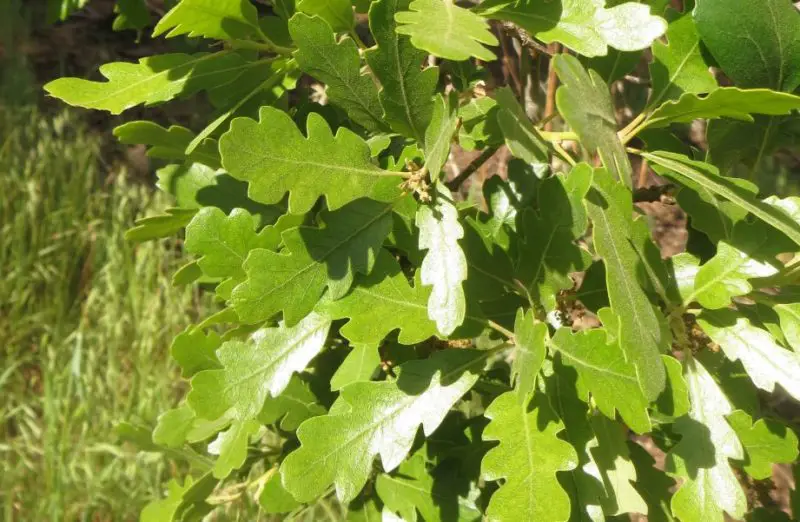
Southern Live Oak Hybrid is a naturally occurring or cultivated cross between Quercus virginiana and closely related species like Quercus fusiformis. It combines traits from both parents, typically resulting in a medium to large evergreen tree with a dense canopy and improved cold tolerance compared to standard Live Oaks.
The leaves are leathery, dark green, and persist through winter, with a shape that varies between rounded and slightly toothed depending on parentage. The bark is dark and furrowed, developing a strong, gnarled appearance as the tree matures. This hybrid thrives in USDA zones 6 to 9 and prefers full sun.
Often planted in transitional regions where true Live Oaks may struggle with cold, this hybrid offers the same shade benefits and aesthetic appeal. Its acorns feed a variety of wildlife, and its resilience makes it a reliable choice for streetscapes, ranches, and windbreaks. Its growth is moderate, and it benefits from occasional pruning to shape its canopy.
Mexican Blue Oak (Quercus oblongifolia)

Mexican Blue Oak is a small to medium-sized evergreen oak found in dry mountainous regions of southwestern Texas, New Mexico, and northern Mexico. It typically grows 15 to 40 feet tall with a rounded or spreading canopy. Its distinctive bluish-gray foliage and high drought tolerance make it attractive for xeric landscaping.
The leaves are oval to oblong, 1 to 3 inches long, with smooth edges and a waxy blue-green to silvery-blue surface. They remain on the tree year-round, adding striking color to arid landscapes. The bark is smooth and gray when young, becoming fissured with age. This oak performs best in USDA zones 7 to 9 and prefers full sun.
Mexican Blue Oak is excellent for rock gardens, hillsides, and water-wise landscapes. Its drought resistance and low maintenance requirements make it suitable for areas with poor soils and limited water. The small acorns are an important food source for desert wildlife, and its foliage offers cover in otherwise sparse environments.






